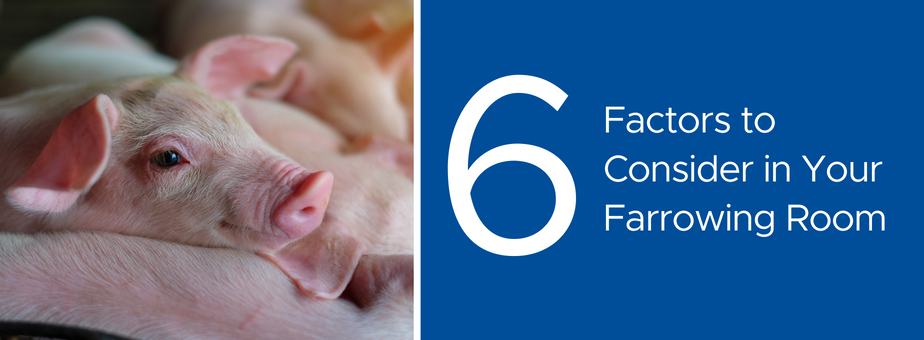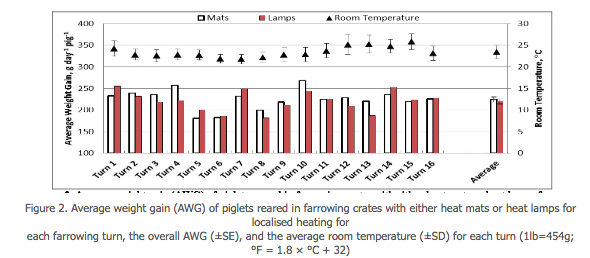
Farrowing is one of the most precarious areas on a farm. Everything leads up to and flows from this one activity. So it only makes sense that farrowing rooms should get attention too! We have gathered a list of six important factors to consider in your farrowing room.
1. Staff it With Careful Workers
If there are issues with your farrowing room, you want to make sure the staff you've placed in that room are on top of it. As one of the most important rooms in the barn, you need to make sure it is staffed with conscientious, careful, and gentle workers who will keep the pigs at ease. Female workers with a strong mothering sense can be a great fit in this room as that mothering instinct translates well to being great with animal husbandry.
Some farms choose to staff this room 24 hours a day so that they can maintain even more consistency with the animals. This is a great option if your budget and staffing situation allow.
2. Decide on Heat Mats vs. Heat Lamps
Heat lamps may be the more common tool used to keep your farrowing room warm enough for the piglets, but heat mats might actually be the way you want to go! According to research at Iowa State University, there weren't many differences between the heating systems when it came to outcomes in piglet mortality or performance. There was, however, a pretty significant difference in the amount of power used.
In their study, Iowa State found that the amount of power used with heating mats over power used with heating lamps resulted in a 36% saving. Their math indicated that the mats save roughly $0.14 per piglet, which when you consider how many piglets are weaned a year could make a rather noteworthy difference. Check out their graphs below for more information!



Ultimately, it comes down to customer's preference. Heat lamps aren't bad and generally have a lower cost up front. In colder climates, you may even want to combine the two to make sure the youngest members of your herd stay warm!
3. And Don't Forget the Anti-Draft Mats
In addition to the heating elements, you may want to install anti-draft mats underneath the floor. Newborn piglets are ill equipped to keep themselves warm in those early days and weeks. They are born wet, without hair, have more skin that body fat, and have a limited ability to produce their own body heat.
Slats in the floor can often create drafts that can cause piglets to become too cold which leads to all sorts of health and feeding issues. If you add anti-draft mats, the piglets will be better able to stay dry, healthy, and happy!
4. Install Nedap Electronic Farrowing Feeders
For sows that are used to ESF in the gestation barn, the Nedap Farrowing Feeder offers a similar experience with robust data so you can quickly spot problem sows before emergencies arise. With the farrowing feeder you can set a feeding curve specific to each unique sow, taking into account her body condition, lactation stage, number of piglets, and overall health. And just like ESF systems they can help single out and flag sows that might be sick or struggling.
5. Think About Choosing PanelTIM Creep Penning
We firmly believe that PanelTIM is the best choice for farrowing rooms as it is easy to install and easy to keep clean. When piglets are small they are at the greatest risk of acquiring fatal diseases. PanelTIM penning's non-corrosive polypropylene material means that it is easy to clean between farrowing groups, minimizing piglets' risk of exposure to foreign pathogens. The paneling is also tough and able to withstand the pressure of large sows without breaking or shattering.
6. Remember That Size Matters
We all like to think that size doesn't matter, but when it comes to your farrowing room it does! The standard size of a farrowing create should be 6x8 feet, but a lot of designs are still going with a smaller area. While it may not seem like a big difference, the extra 6.75 square feet (when compared to a 5.5’ x 7.5’ crate) can make a huge difference for the comfort of sows and piglets without adding much space to your building.
In addition, according to John Deen with the University of Minnesota Swine Group, "a sow that is lame at entry into the farrowing stall has a 40% higher mortality rate, even if the lameness appears to be minor." Throughout the transition from gestation to farrowing stalls, if a sow has more space to get up comfortably, issues of lameness are decreased. And with decreased lameness comes decreased chances of compromised weaning—which can often lead to a higher rate of culling. All in all, the more space the better!
Did you enjoy these tips and want to learn more? Click below to subscribe to the blog and get updates when we post!




.png?width=600&name=Polypropelene%20vs.%20PVC%20(1).png)

